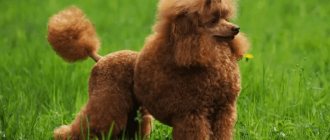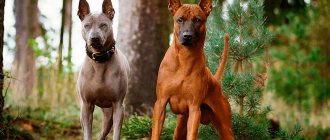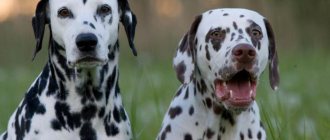The English Setter is a friendly and cheerful companion. This graceful, long-haired dog with an attractive appearance was bred for hunting. But the breed is also popular among ordinary dog breeders. Despite the developed hunting instincts, the setter can be kept in a city apartment. This is a smart, affectionate and sociable pet. But before getting an English Setter, you need to study the description of the breed, the pros and cons, and reviews from the owners.
- Head
- Features of education and training
- Nutrition
Breed traits
Breed traits (on a 5-point scale)
| English Setter | |||
| Activity | in the house | 2.1 | |
| on the street | 4.4 | ||
| Obedience | training | 3.5 | |
| strangers | 3.9 | ||
| Domination | in family | 1.4 | |
| over dogs | 2 | ||
| Defending your territory | from people | 1.9 | |
| from dogs | 2.2 | ||
| Sociability | in family | 4.8 | |
| with strangers | 3.9 | ||
| with dogs | 3.6 | ||
| Concentration | in family | 1.2 | |
| in front of strangers | 2.2 | ||
| with dogs | 2.4 | ||
| Aggressiveness | in family | 1 | |
| to strangers | 1.4 | ||
| to the dogs | 1.7 | ||
| to cats | 2.1 | ||
| Family behavior | calmness | 3.8 | |
| demand for affection | 4.5 | ||
| excitability | 2.9 | ||
| playfulness | 3.8 | ||
| excessive barking | 2.5 | ||
| behavioral breakdowns | 1.5 | ||
| Tolerance for children | up to 4 years | 4.6 | |
| over 4 years old | 4.2 | ||
| Institutional use | watchman | 3.4 | |
| bodyguard | 1.5 | ||
This breed is often compared to the following dog breeds: American Cocker Spaniel, Golden Retriever, Labrador Retriever, German Wirehaired Pointer, Irish Red Setter.
The photo shows what an English Setter looks like:
Health
The average lifespan of an English Setter is 12 years.
In order for your pet to get sick less often, it is important to vaccinate on time and give anti-worm medications. It is also advisable to visit the veterinary clinic with your dog annually for tests, x-ray examinations and preventive examinations.
The owner of an English Setter should know that representatives of this breed are predisposed to the following diseases:
- Bloating - a balanced diet and a diet tailored to all the specific characteristics of the English Setter will help avoid this problem.
- Blindness is congenital, hereditary.
- Joint dysplasia is a hereditary disease that can be caused by puppies and young animals running up stairs or jumping high. The disease is treated both surgically and with medication.
- Growth disturbance - occurs due to improper nutrition.
- Allergic reactions are often food related.
Characteristics of the English Setter breed
English Setters are elegant, beautiful dogs that are popular among dog breeders. They are medium in size, have a recognizable appearance with beautiful fur of an unusual speckled color. Another name for English setters is Laverack, named after the breeder who has been breeding them for about 50 years.
These are playful, loyal and affectionate pets. They can become a faithful companion who is ready to follow the owner everywhere. The devotion of setters is known from the book “White Bim Black Ear,” which tells about one of the varieties of the breed. These dogs remain faithful to their owner until the end of their lives. Another feature of the breed is artistry. They act in films and commercials.
English Setters are classified as pointing hunting dogs. The breed was bred for bird hunting. It has endurance, high speed, a sensitive sense of smell, and an obedient, balanced character. This is a working breed, dogs need physical activity. They easily learn various tricks, can participate in sports competitions, and show good results in agility, Frisbee, and freestyle.
For their sensitive sense of smell, representatives of the breed are valued by the police and are used in rescue work. They will not be able to become a watchman or a security guard, since they are not at all aggressive and friendly towards all people, but are the best companions.
| Options | Characteristic |
| breed name | english setter |
| country of origin | Great Britain |
| group of breeds according to the ICF classification | cops |
| application | hunting dog, companion |
| life expectancy | 10-12 years |
| height | males 65-68 cm, females 61-65 cm |
| weight | males 25-36 kg, females 20-32 kg |
| aggressiveness | low |
| activity | high |
| character traits | friendliness, optimism, sociability, devotion |
| complexity of content | Difficult coat care, heavy shedding |
| health | strong |
pros
English Setters are one of the popular dog breeds. Suitable for inexperienced dog owners and families with children. These pets have many advantages:
- do not show aggression towards humans at all;
- love children, treat them with care, are able to become a nanny;
- get along with any pets except birds, are not prone to dominance, competition or jealousy;
- never come into conflict with other dogs;
- smart, quick-witted, easy to train;
- very sociable, ready to support any activity of the owner;
- understand a person’s mood and will never impose themselves;
- adult pets behave calmly with sufficient physical activity at home;
- unpretentious, easily get along in any conditions;
- clean, no smell from the wool;
- rarely bark;
- hardy, fast, retaining developed hunting qualities.
Minuses
But this breed was bred for hunting and for many years was used only for this purpose. When kept as a companion, these dogs may have some disadvantages:
- need a lot of physical activity;
- This is a long-haired dog that sheds heavily;
- can be stubborn, which makes training difficult;
- cannot stand loneliness and can become depressed from a long separation from their owner;
- can hunt birds while walking;
- if kept on the property, they can jump over the fence and dig under the ground;
- mature late, playful puppy behavior appears before 2 years of age.
Education and training
English setters are considered to be highly trainable. Quite obedient animals perceive human commands and demands quite well, but increased activity will make the learning process difficult.
Education and training of the English Setter should begin from the first days the puppy appears in the family. To begin with:
- accustom the dog to the toilet and hygiene standards;
- teach you to respond to the owner’s voice and your nickname;
- develop the ability to walk on a leash while walking.
It is very important that training and feeding are handled by one person, that is, the owner. This will make it easier for the baby to get used to the requirements. They must be presented consistently and firmly, without making concessions, otherwise the pet will not understand what is needed from him.
You should not shout at the puppy or praise him too much, because the dog easily gets used to such extremes of upbringing and it will be quite difficult to cope with him in the future.
Thanks to the high intelligence of the pet, it is easy to accustom it to different commands in a short time. But his keen mind also allows him to selectively fulfill the owner’s demands. If the setter doesn’t like something, it’s unlikely to force him to do it.
History of the origin of the English Setter breed
English Setters are one of the oldest hunting breeds. Developed in England over 400 years ago. Now the breed is the most popular variety of long-haired pointers. The ancestors of the representatives of the breed were spaniels. This breed was popular in the Middle Ages in Europe. Spaniels were most often used for bird hunting. They would sneak up on their prey and take a stance.
This method of hunting determined the name of the English setters. It is associated with the combination to set, which means “to make a stand.” Sometimes the word setters is translated as “crouching.” This is also due to the behavior of dogs when hunting - they sneak up on prey, crouching to the ground.
In addition to spaniels, greyhounds, retrievers, hounds, and poodles were used in breed selection. The main attention was paid to the working qualities of the dogs. Only in the 19th century did breeders pay attention to their appearance. Edward Laverack began breeding the breed. He managed to create graceful, elegant dogs with a balanced character and excellent hunting qualities. That's why the breed was called the Laverack Setter.
In the 70s of the 19th century, the breed was recognized by the English Kennel Club. At this time, the first standard appeared and exhibitions began to be held. The dogs came to America, where they also became popular. The breed was often used by Russian hunters. Setters were the favorite dogs of Nicholas II; many famous writers kept representatives of the breed.
Since the beginning of the 20th century, the English Setter has become less popular. Interest in the breed increased only towards the end of the century. Modern setters are bred mainly as companions, although they have retained their working qualities.
Appearance Features
English Setters are medium in size. This is a strong, resilient dog with strong bones and pronounced muscles. The appearance is attractive, the physique is graceful and harmonious. Features: speckled color, rounded skull, silky coat. Males are heavier and larger. The average height of an English Setter at the withers is 61-61 cm, males weigh from 25 to 36 kg, females weigh less.
Head
The head is light, harmonious, proportional to the body. Rounded between the ears, filled in under the eyes. The occipital protuberance is pronounced, the stop is clear, the brow ridges protrude slightly. The muzzle is moderately narrow and elongated. The length is the same from the back of the head to the stop. The bridge of the nose is straight, the cheeks are flat.
The lips fit tightly to the jaw, the upper one hangs down slightly. The edging of the lips in red or white individuals is brownish, in dark ones it is black. There are small folds at the corners of the mouth. The nostrils are wide, mobile, very sensitive. The English Setter's nose is black or brown. The jaws are powerful and have a scissor bite. The teeth are strong, the fangs are large.
The ears are set at eye level and covered with long hair. They are soft, thin, triangular in shape. The ears droop, the tips touching the cheeks. The eyes are oval, set deep and wide. They are brown in color; in white individuals they may be lighter. The look is smart, attentive, a little sad.
Torso
According to the breed standard, the body format of the English Setter is stretched. The length is slightly longer than the height at the withers. The neck is long, oval, muscular, without dewlap. It gradually widens towards the withers. The scruff is convex, the withers are pronounced. The back is short and straight, the loin is wide. The chest is convex, the stomach is tucked.
The tail continues the line of the back, it is of medium length, tapering to the tip. It has a saber shape. In a calm state, it is lowered down; when excited, it rises, but does not twist or roll over its back. The tail is covered with long silky hair.
Limbs
The forelimbs are straight, long, and set parallel. The shoulder blades are directed back, the elbows are pressed to the chest. The hind legs are muscular and point backward when standing. The hips are wide and long, the joints are clearly defined. The paws are oval, the toes are gathered into a ball. The pads of the fingers are convex, rough, the claws are strong. The space between the toes is filled with fur.
English Setters move easily and gracefully. They run quickly, with a strong push of their hind legs. When moving, the dog maintains correct posture and carries its head high.
Coat and color
English Setters have a silky, shiny coat. The length varies in different parts of the body. On the head and the front surface of the limbs it is short, on most of the body it is of medium length. On the ears and chest it is longer and thicker. Panties form on the legs, and long feathers on the lower part of the tail.
The colors of the English Setter can be different, usually two-tone. The most common are white with black, yellow with brown, white with red, always with specks. This color is called “Belton” after the name of the village where this breed was bred in the 19th century. The color can be lemon, brown, red, bluish-white.
Single-color colors are possible. But even white English setters have markings on their limbs. May be silver-gray or tri-color with brown or red tan. According to the standard, the spots should be evenly distributed; the smaller they are, the better.
The photo shows the appearance features of setters:
Varieties
In the 19th century, there were three types of setters based on color:
- Irish or red setter;
- Scottish or Gordon Setter – black and red tan;
- The English branch of the breed is white dogs with red, brown or black markings.
The English branch of setters also has varieties. They are associated with disagreements among breeders. Laverack bred a hunting type of dog. They are characterized by a strong build and resemble spaniels in appearance. Breeder Llewellyn crossed the dogs with other breeds. This variety is larger and the dogs have a more attractive appearance. They participated in exhibitions more often, so they almost lost their working qualities.
Disqualifying faults
The standards clearly define the characteristics of the breed. With such deficiencies, the dog may be disqualified:
- wavy coat;
- high-set ears;
- very short tail;
- wide-set eyes;
- very sharp or short muzzle;
- pronounced jowls;
- light eyes;
- solid color without specks;
- thick short neck;
- the tail is wrapped in a hook;
- clubfoot.
Photos complement the description of English setters:
Character of English Setters
The English Setter is people-oriented. This is a friendly, affectionate and sociable dog. He is ready to accompany his owner everywhere and participate in all his affairs. The dog will keep you company during walks, sports, games, or just sit next to you while watching TV. Setters love communication, happily accept even strangers, and are very affectionate.
These dogs love children and treat them with care and affection. They support all games and tolerate pranks. The English Setter is considered the best nanny. This good-natured, non-conflict and calm dog is ideal for families with children. Gets along well with other pets.
Despite its developed hunting qualities, it does not perceive even rodents or poultry as prey. After all, its purpose is to indicate the location of prey, and not to catch it.
Reviews from owners and breeders note that English Setters:
- cheerful;
- playful;
- good-natured;
- energetic;
- sociable;
- affectionate;
- devotees;
- flexible;
- patient;
- sensitive;
- balanced.
This nature makes representatives of the breed unsuitable for protection. The setter does not seek to defend the territory, is completely devoid of aggression, and sees a friend in every person. But he becomes strongly attached to his owner and remains faithful to him until the end of his life. He gets very bored when apart and can become depressed. You should not leave your pet alone for a long time.
The English Setter is very active, energetic, and hardy. He needs walks 2 times a day for an hour. It is important to let your dog run; it needs exercise. This especially applies to the working variety of the breed. If there is a lack of activity, the dog will try to throw out the accumulated energy at home and may spoil things.
Features of education and training
The English Setter is a smart, obedient dog. He easily learns commands. But due to the tireless energetic temperament and natural stubbornness, difficulties in training may arise. It should also be taken into account that representatives of the breed mature late. They are carried away by the game and do not pay attention to the words of the owner.
You need to raise a setter puppy from the first days of his arrival in the house. He must understand that the owner is in charge. You need to be consistent, patient and persistent. You shouldn’t shout or hit your pet, but you shouldn’t let your puppy do a lot either. In a playful way with affection and treats, it is quite easy to teach the setter the following commands:
- place;
- to me;
- near;
- stand;
- sit;
- lie;
- it is forbidden;
- voice;
- bring it.
These dogs also easily learn tricks and can participate in agility, frisbee, and freestyle. But due to stubbornness, the pet may not want to carry out the command, although most setters are afraid of upsetting the owner. In case of disobedience or incorrect behavior, it is enough to strictly scold the pet. To achieve success, classes must be structured in the form of a game, they must be varied.
Hunting with English Setters
The English Setter is a passionate hunter. In searching for game, he has no equal. He loves to run through fields and stalk prey. This is a versatile gun dog with a keen sense of smell, hardy and tireless. Easily finds birds in thickets. And thanks to its characteristic color, the dog is noticeable from afar.
Although the English Setter has natural hunting skills, it requires special training. They start it at 4 months, teaching the puppy to look for and bring hidden objects. From 8-9 months you need to take the dog out into the field and train it to hunt birds.
The photographs show how they hunt with English setters:
Learning ability
Training a setter is not easy - the dog reacts sharply to the slightest changes in the tone of voice and behavior of the owner. He is ready to work only in a calm environment - any scream, spank or punishment will be a reason to stop training.
The active disposition of a laverak can become a reason for the owner's dissatisfaction - but there is no need to punish the dog, especially a young one, for showing emotions. It is better to let the dog “let off steam” before training, run around and only then give commands.
The setter must know and automatically execute prohibiting commands and the “come to me” command. Thanks to his keen sense of smell, he perfectly smells the smell of stale “goodies” on the street, as well as small cats and birds, and at any second he can chase them. This is where a well-practiced skill comes in handy - any manifestation of the hunting instinct must be controlled.
The dog cannot live in a cage or enclosure - it needs constant contact with a person. In an apartment, the setter must be able to move freely around the rooms, otherwise he will begin to chew things and furniture.
English Setter
Dog care
The English Setter is well suited for keeping in a house or apartment. If there is a fenced area near the house, it is recommended to give your pet free access there so that he can run around. But English setters cannot tolerate drafts and cold. It is necessary to equip a place for the dog in a secluded corner of the house, put a soft mattress there.
The pride of the breed is its long, silky coat. This makes caring for a pet difficult, especially for new dog owners. Heavy shedding can cause problems, requiring frequent house cleaning and may cause an allergic reaction in some people.
It is recommended to brush the coat daily. You will need a rubber glove and a soft and hard brush. And once a week, thorough combing is required. To do this, it is better to use combs with long, sparse and frequent teeth, and a brush with natural bristles.
Particular attention should be paid to the paws, belly and tail, where tangles often form. The slicker should be used carefully, moistening the wool with conditioner. It is recommended to cut the hairs between the fingers. Show dogs also require trimming. The hair on the head and ears is trimmed.
It is not recommended to bathe a setter often; once every 1-2 months is sufficient. Use only mild dog shampoos and warm water. The dog's skin and hairs are covered with a layer of fat. The wool does not get dirty much and has no smell. In addition, representatives of this breed are very clean. They love water and enjoy swimming in ponds and snow.
If it is dirty outside, it is recommended to wear waterproof overalls on your pet. Every time after a walk you need to wash your paws. The body can be wiped with a damp towel, this will help keep the coat clean.
The setter's long ears require careful care. If dirt is not removed regularly, it can cause inflammation. It is recommended to wipe the ears with a special lotion or boric acid solution. You also need to regularly wash your pet’s eyes, preferably with tea or chamomile decoction.
The English Setter does not like to walk on asphalt. That's why his claws don't wear well. As they grow, they cause discomfort to the dog. Therefore, at least once a month it is necessary to shorten them with a nail clipper.
Nutrition
English Setters are not prone to gaining weight as they are very active. They eat to satisfy hunger and are unpretentious. This dog needs to be fed twice a day. You can give natural food or dry food.
These dogs need a lot of protein. Therefore, meat should be the basis of the diet. It is useful to give your pet sea fish, offal, and fermented milk products. They are mixed with cereals, fresh and stewed vegetables. You can pamper your pet with fruits, cheese, and boiled egg yolk. It is recommended to add herbs, vegetable oil, and vitamin supplements to food.
The following foods are prohibited for dogs:
- milk;
- fat meat;
- River fish;
- legumes;
- smoked meats, sausages;
- chocolate and other sweets;
- confectionery fresh bread;
- spicy, fried, salty dishes
You can feed your pet premium or super-premium dry food. It should not contain vegetable proteins, preservatives or dyes. You need to choose options designed for active large breed dogs.
Health
Despite the fact that English Setters are in good health, their life expectancy is short. Most dogs live 10-12 years. But with proper care, the age of representatives of the breed can reach 14 years.
When breeding these working dogs, breeders selected the strongest and healthiest individuals. If you get all your vaccinations on time and regularly treat them against parasites, setters rarely get sick. But sometimes they are prone to the following diseases:
- hip dysplasia;
- congenital deafness;
- food allergies;
- paralysis of limbs;
- retinal atrophy;
- volvulus;
- epilepsy;
- hypothyroidism
Photos complement the description of the breed representatives:
Price
Every year more and more breeders of this beautiful breed appear in Russia, and accordingly, the number of families ready to shelter an Irish Setter is also increasing. This is a popular dog in our area. People love him not only for his bright appearance, but also for his good-natured disposition.
Irish Setter puppies are also sold in kennels. These institutions will provide you with information about each dog that is available for sale. You can also learn there about the history of the breed and the rules for caring for it.
The average price of an Irish setter in Russia is 15-20 thousand rubles. Show class dogs are sold from 40 thousand rubles. If pedigree is not important to you, then we do not recommend overpaying for a dog. There are a lot of advertisements on the Internet for the sale of beautiful four-legged hounds at prices below 10 thousand rubles.
How to buy an English Setter puppy
A purebred puppy can only be purchased from an experienced breeder or nursery. You can buy a dog with deviations from the standard or with hereditary diseases from your hands or at the poultry market. When buying a puppy, you need to get to know the parents and study the living conditions of the animals.
Ask the breeder for a certificate of the dogs’ health and pedigree. An English setter costs an average of 25-30 thousand rubles. For an elite puppy, a descendant of exhibition winners, you will have to pay 70-80 thousand rubles.
When choosing a puppy, you first need to decide on the gender and color of the dog. They sell babies at 3-4 months. A healthy puppy should be active, playful, and not cowardly. The eyes are clear, clean, the coat is smooth, the paws are straight and strong, the belly is not bloated.
It should be taken into account that English Setter puppies are born without markings. A beautiful coat with a characteristic color appears in representatives of the breed only after a year.
Photos of English Setter puppies:
An interesting video complements the characteristics of English setters:
Video: English Setter - Interesting facts about the English Setter breed
Video: English Setter. Breed characteristics, care
Video: English Setter
English setters are popular dogs not only among hunters. This is an intelligent, affectionate and obedient companion, a wonderful pet for families with children. An excellent choice for an active owner who needs a cheerful, loyal friend. And in return, the dog only needs the attention of the owner, proper care and affection.
Why are they chosen?
If we talk about the correct selection of food for a setter, then first of all it should be balanced. But at the same time, you need to remember that this animal is susceptible to various diseases of the digestive tract. This could be a gastric volvulus or other problems. The dog may also develop hepatitis or spasm of the pharyngeal muscles. Dysplasia or inflammation may also develop in the joints.
And, of course, one cannot miss another important feature of the setter: intellectual ability. They are quite smart, and the dog treats its owner with exceptional respect. Therefore, you need to try to answer them in the same way. You need to talk to him, you can communicate on different topics. And literally after a short period of time it becomes clear that this animal is the most devoted friend in a person’s life and completely understands him in everything.
Many pet lovers, having decided to purchase this particular breed, wonder which type to choose. Of course, it all depends on a person’s individual preferences and preferences. But if you need an excellent friend and pet, then it is better to choose a dog of imported blood. She is more intellectually developed and adapted to life next to a person. Well, if you need an animal for hunting, then you can take a domestic brood dog.
It must be remembered that the latest specimens are very much focused on hunting. Therefore, you should remember this. For example, if you plan to live in the city, you need to understand that the dog will constantly look for the subject of hunting - squirrels, birds, rats, etc. Also, we must not forget about periods of estrus. At this time, you must not let the animal off the leash. They have a very developed sense of smell and, once you let a setter off the leash during estrus, you may never find him again.











